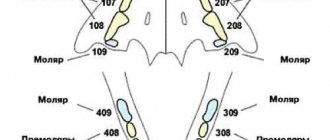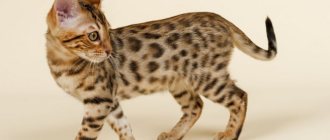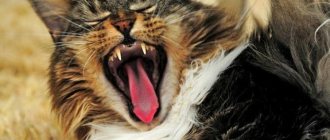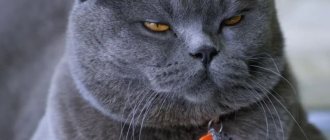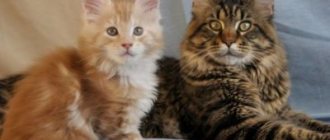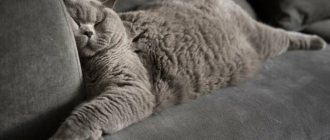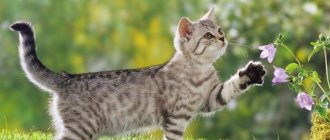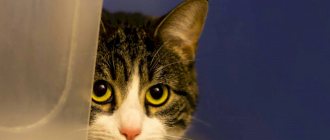Formation of primary dental occlusion
Almost all mammals are born toothless. Cats are no exception: the oral apparatus of a newborn kitten is maximally adapted for effective sucking. After all, the only food available to him is mother’s milk.
At two weeks of age, kittens develop milk teeth - straight, small, sharp, milky white. In adult cats they are powerful and curved. They are called milk teeth because they appear in kittens during breastfeeding.
Interesting! The front milk teeth of kittens are straight, and the fangs are curved.
Teething order
The eruption period lasts up to two months. By this age, the cat already has 26 baby teeth. They do not appear all at once, but in a certain order:
- 2–4 weeks. Incisors appear. First, 2 in the center of the jaw, then 4 more are added to them on both sides. There are 12 incisors in total - 6 each on top and bottom.
- 3–4 weeks. Fangs appear: 4 upper and 4 lower. They are located on the sides of the incisors.
- 4–8 weeks. The appearance of pre-masticating teeth - premolars: 4 on the lower jaw and 6 on the upper jaw.
Important! Milk teeth will serve kittens up to the age of 3-4 months with proper care and timely introduction of complementary foods.
Results
All breeds of kittens need calcium support during teething - give them cottage cheese, cream and milk, fermented milk products. Their fat content should be neither high nor zero. Don't forget about the proteins contained in meat and chicken cartilage. Phosphorus is found in sea fish, and porridge is a source of carbohydrates. Complex vitamin and mineral supplements should support your immune system.
Dental care may include periodic examination for inflammation or stone formations. Teeth brushing should be done for pets who eat small pieces of wet food. The procedure is carried out daily and from a very early age.
After washing your hands, the pet is placed on your lap. With one hand they open his lips. The second hand makes circular movements with the brush. Wool should not get into the mouth. After completing the procedure, the pet is praised and treated with something. Owners who take care of their kitten's oral health will prolong their health for a long time.
Changing baby teeth to permanent ones
The replacement of baby teeth with permanent teeth in cats begins at 4 months. The formation of the masticatory apparatus is completed at 7–8 months. The time it takes for a permanent bite to develop may vary among different cat breeds. A slight advance or delay in deadlines is allowed.
Shift order
The location and order of changing baby teeth to permanent ones is clearly depicted in the figure below. The first to fall out are the deciduous incisors. Fangs change after complete replacement of incisors. Next comes the replacement of the premolars. After a complete change, 4 molars erupt - the main chewing ones. In the picture they are colored blue.
Types of permanent teeth
An adult cat should have a total of 30 teeth. For a cat, it is a weapon, a means of protection, defense and attack. Mother cats use their front incisors to gently grab and carry the kitten.
Interesting! In cats, the lower jaw can only move in a vertical plane, so it is incorrect to say that cats chew their food. They crush it, crush it into small pieces.
The table describes the location of cat teeth, their number and functional load.
| Upper jaw | Incisors – 6 | They serve to hold prey and tear off small pieces of food. | Fangs – 2 | Used for self-defense, capturing and chopping food | Premolars – 6 Molars – 2 | They grind the bones and crush large pieces. |
| Lower jaw | Incisors – 6 | Fangs – 2 | Premolars – 4 Molars – 2 |
Molars are located deep in the jaw. Their presence indicates that the cat has become an adult. During this period, he begins to mark his territory.
What you definitely shouldn't do when cats change teeth
At this time, the animal’s immunity is weakened, so in order not to harm your pet, you should not plan vaccination. It is better to postpone the procedure for a month and get vaccinated when the cat’s dental boom is over.
If a cat is teething, this does not mean that he is sick and requires some special privileges. During this period, you should not allow him to scratch and gnaw the hands of the owners, and also allow everything in a row. This behavior can very quickly develop into a bad habit from which the owners will suffer constantly. Make it clear to your pet that he is entitled only to cat toys and not to anything else. And remember, this difficult time will end very soon, and the cat will again delight you with its purring and obedience.
Symptoms of teething or changing teeth
By the behavior of kittens and the reaction of a nursing cat, you can understand that they are cutting their first teeth. The appearance of primary incisors is accompanied by swelling and soreness of the gums. The kitten is trying to get rid of unpleasant sensations, so during feeding it clenches its jaws with force and bites its mother's nipple.
Sharp incisors can injure the nurse. But this period does not last long and often goes unnoticed by the owners.
By the end of the 4th month, the rudiment of a permanent tooth is formed in the gums of the upper and lower jaws under each milk tooth. As it grows, baby teeth shift, are pushed out of the gums and fall out one by one. This occurs at approximately 5 months.
Replacing baby teeth with permanent ones causes noticeable changes in the kitten's behavior. During this time, your pet's condition should be monitored to help if complications arise.
Symptoms of teeth changing in kittens:
- When young cats lose their baby teeth, they become biters in an attempt to get rid of itchy gums. You should not allow the kitten to bite the owner's hands. It will be very difficult to re-educate him later.
- Excessive salivation appears - ptyalism. This is how nature protects delicate gums from possible inflammation.
- An unpleasant odor appears from the mouth. The reason is moderate inflammation.
- Possible increased body temperature, lethargy or agitation, aggression. This is a reason to contact a veterinarian.
- Kittens lose their appetite or refuse solid food because their swollen, inflamed gums are painful to chew. Dry food should be removed from the diet, leaving only soft food.
Important! When kittens change teeth, it is necessary to exclude the animal from access to anything that could harm it. For example, when chewing wooden surfaces, a cat can hurt its gums.
To make the teething process go smoothly, you can purchase special “chewing” toys.
Lost primary incisors can be discovered by the owner during play. But most often kittens swallow them while eating. This is normal - everything will work out naturally.
Care and feeding
Changes in teeth in cats can make themselves felt as early as six months later, so owners should know how to properly care for their pet so that the process goes faster and less painfully. It is important to monitor the behavior of British cats and representatives of other breeds, preventing them from chewing furniture, shoes and other objects in the house. As a relief, the kitten is capable of biting the owner's fingers or toes, but this should not be allowed, since the habit can become a serious problem in the future. During the period of teeth change, it is worth observing a special diet, adhering to the following recommendations:
To ensure a sufficient amount of calcium for the animal’s body, it is recommended to include cottage cheese in its diet.
- Avoid very soft food, since the kitten may inadvertently swallow lost teeth, resulting in damage to the esophageal mucosa. It is recommended to introduce food of coarse consistency and large size into the diet.
- The meat is given in large pieces, with preference given to beef, turkey, and chicken. You first need to scald or boil it.
- Add cottage cheese and other fermented milk products, which contain a lot of calcium, to your daily diet.
- It is possible to add drops or small tablets of phosphorus to the main diet. It is possible to purchase such drugs at a veterinary pharmacy, and many of these drugs contain a small analgesic substance that eliminates pain when changing teeth.
- Twice a week the kitten is fed boiled sea fish, for example, hake.
- The diet is replenished with foods filled with vitamins A and D.
- It is recommended to let the kitten chew on special bones, which are previously purchased at a pet store. They consist of vitamin supplements, thanks to which you can not only scratch your gums and strengthen your growing teeth, but also get the necessary vitamins.
Possible complications
The eruption of baby teeth and their replacement with permanent teeth are natural processes of growth for any animal. They must take place on time. It is necessary to contact a veterinarian in time if complications arise:
- The kitten has been sleeping poorly for the last 24 hours, not eating, restless, and meowing.
- The unpleasant odor does not go away for a long time, it becomes pungent - periodontal disease may develop.
- Excessive secretion of saliva and its thickening - the likelihood of gingivitis or stomatitis.
In order not to miss alarming symptoms when cats change teeth, you need to regularly examine the oral cavity.
Gum inflammation
A healthy cat's gums should be pale pink and free of swelling. During eruption, swelling, redness, slight swelling and short-term bleeding are allowed. These phenomena quickly pass: the swelling quickly subsides, the hole in the place of the lost tooth heals without a trace.
You should not postpone a visit to the veterinarian if:
- inflammation has occurred around the baby tooth;
- Reddened gums bleed for a long time;
- pus appears on the gums or in the sockets;
- the baby incisor is “slanted” and injures the gums, this usually happens with fangs.
All of these signs are symptoms of periodontal disease, stomatitis, and gingivitis. Purulent inflammations are especially dangerous.
Interesting! Scottish Fold cats are the most prone to gum disease. The owners of Scottish dogs should be especially attentive to them during this difficult period.
Residual baby teeth
Usually the new tooth grows in its own socket. Therefore, it often happens that a permanent one grows next to a milky one that has not yet fallen out. This is the norm, but if a baby tooth does not fall out in 8 months, this is a reason to consult a doctor.
An anomaly, when permanent teeth have already erupted, but milk teeth have not yet fallen out, is rare. In this case, a double dentition is formed and, as a result, an incorrect bite. In this case, the oral mucosa, the inside of the cheeks, and the kitten’s tongue are injured.
If more than one or two primary incisors remain in the pet's jaw, surgical intervention and strict monitoring of the subsequent eruption process are inevitable.
Expert opinion
Chepa Natalya Semenovna
Veterinarian
Ask an expert
In some cases, kittens may develop juvenile gingivostomatitis after teething. This is an inflammation of the gums that develops after the appearance of permanent teeth. Young cats under 2 years of age are affected. The exact causes of the inflammatory process have not been fully established. The disease probably occurs against the background of an allergic reaction of the body to plaque bacteria. Some breeds have a predisposition: Maine Coons, Sphynxes, Bengals, Orientals. Characteristic signs of juvenile gingivostomatitis are bad breath, redness and swelling of the gums. To treat the disease, sanitation of the oral cavity with antiseptics, for example, Miraxidin solution, is prescribed. In difficult cases, ultrasonic teeth cleaning may be required. To prevent the disease, it is recommended to brush your pet’s teeth with special pastes for animals. Moreover, it is better to accustom your cat to the procedure from childhood.
What to do and how to relieve the kitten’s discomfort?
It is recommended to buy special chewing toys for the kitten during the change of teeth.
When pets change their teeth, they often experience pain that does not allow them to live their previous lives. If a cat’s fang or molars are protruding, then to alleviate the discomfort, owners are advised to purchase special rodents or bones from the pet store, on which the animal can scratch its gums. For this reason, as soon as a kitten’s tooth falls out, it is worth removing all electrical appliances, shoes and other items that the baby can damage. If a cat experiences increased salivation when changing teeth, then no measures should be taken. In most cases, this symptom does not cause discomfort to the kitten. If his face is constantly wet, then periodically it can be wiped with a soft cloth or dry cloth.
When a kitten's teeth grow, its body may be constantly in a state of stress. Owners are advised to treat the baby with special attention, surround him with love, care and attention. Frequent contact with your pet and various games will distract him from changing teeth and reduce discomfort. During this process, the pet often rubs against the corners of furniture or the owner’s legs. You shouldn’t forbid him to do this, because with such actions he is trying to calm himself down and scratch his gums. It is also important to pay attention if these signs are not observed, as they may indicate a problem, so it is recommended to take the kitten to the vet.
Classification of plates for teeth straightening
According to use, the equipment is:
- removable;
- non-removable.
Removable
– the simplest design, and is installed on children from 7 to 15 years old for short-term correction of teeth or bite. Fixed with hooks and worn daily. The duration of wearing is determined by the attending physician. They are most often made of plastic, but sometimes they come in complex designs that include springs and screws. The doctor periodically adjusts the device to obtain gentle pressure on the teeth. This achieves a positive therapeutic effect. The teeth are straightened and the bite is corrected. Such equipment is used when it is not possible to correct the defect using only a plate. Can be installed on both the upper and lower jaw.
Fixed (stationary)
– installed once using fixing brackets that prevent movement when eating, for up to two years. Monitoring and adjustment is carried out by the attending physician during a scheduled visit. It is most often used for young children and to correct serious developmental defects of the jaw apparatus.
Differences:
- stationary is more effective in correcting defects. More expensive than the removable version;
- removable, easy to remove at any time. Easier to care for.
According to the material of manufacture:
- metal;
- plastic.
Metal
– made of titanium-nickel or titanium-molybdenum alloy, which do not oxidize in the aggressive environment of the oral cavity. Outwardly it looks like a combination of wires and hooks. It can be either removable or non-removable. Used to treat children of all ages.
Plastic
– most of these plates are removable and are intended for treating children of middle and older age groups.
By purpose and device:
- Single-jaw – used to restore the dentition when it is shortened or narrowed, as well as to eliminate defects of individual teeth. Consist of a plate with adjustable orthopedic screws. Suitable for children of all ages.
- With retraction arch. Correct protrusion of teeth in a row. Based on the elastic properties of the arc. Suitable for correction on both jaws.
- With a hand-shaped process on an arch. Correct the position of individual teeth. The process puts pressure on the tooth and aligns its position. Can be installed on both the upper and lower jaw.
- With active pusher. Used to straighten the maxillary anterior incisors. The dentition is aligned with spring mechanisms for each uneven tooth.
- The Andresen-Goipl apparatus (activator) is a removable orthodontic device of combined action designed to correct occlusal defects. The activator makes it possible to fix the lower jaw in the required (extended) position, which gives impetus to its development. In this regard, the growth of the upper jaw is inhibited, the bite is disconnected, and the work of the facial and masticatory muscles returns to normal. Placing the inclined plane of the plate along the entire dentition makes it possible to move teeth in three planes - to the side, back and forward. This allows, with some design changes and additions to the activator, to successfully use it to correct not only distal occlusion, but also other deviations of occlusion.
- Bruckle's appliance is a removable device designed to correct deep mesial bite. It is installed only on the lower jaw, and, due to its design features, it has a positive effect on both dentitions.
- Frenkel apparatus - lip pads, brush shields, and other additional elements are installed on a metal frame. The device is attached simultaneously to both jaws and has a functionally targeted action that limits unnecessary muscle force. The use of the device promotes the normal development of the jaws, dental arches and rows. Open, distal and mesial bites are corrected, but the complexity and duration of production, as well as the high cost, do not contribute to its popularity.
The procedure for adjusting and installing the plate is simple and painless. At first, the child feels discomfort from the presence of the equipment in the mouth, but then he gets used to it.
Changes in the well-being and behavior of kittens
Teeth germination is painless, but is accompanied by severe itching. The animal scratches its gums: gnaws on inedible objects, bites the owner’s fingers, rubs its muzzle with its paw on the edges of furniture.
At the same time, the following natural changes are noticed:
- A repulsive odor appears from the mouth, because inflammation cannot be avoided. It goes away a month after growth is complete.
- Salivation increases during play and feeding; this is a protective reaction against inflammation of the mucous membranes of the mouth.
- The site where the next tooth appears swells and recovers 1 – 2 days after eruption.
- The animal eats worse, but does not completely lose its appetite.
- Sometimes the temperature rises to 39.5℃, the kitten looks for a warm place and lies down under the blanket.
- Bleeding after prolapse does not exceed 3 minutes.
Milk and molar teeth emerge from different sockets, so often a new one emerges when the temporary one has not yet fallen out. This phenomenon does not require intervention if they do not touch each other, there are no signs of inflammation on the gums, and the period for replacing teeth has not yet passed. Animals are not vaccinated until their bite is formed: their immunity weakens and they become more vulnerable to infections.
This is interesting: Eliminate cat odor
Caring for your cat's teeth
It is useful to sometimes look into the mouth of a domestic animal for a general assessment of the condition of the teeth and oral cavity as a whole, even if outwardly there is no hint of problems with the chewing apparatus. There are no special conditions for caring for a cat’s oral cavity, other than proper nutrition in accordance with age.
Advanced case of tartar in a cat
One of the most common problems with cat teeth is tartar. In nature, predators do not have this problem. Pets who receive dry food or food in large pieces do not have it either. With regular feeding of soft foods, when the procedure of self-cleaning of the oral cavity is excluded, plaque forms on the teeth, which under the influence of bacteria, salts and food debris turns into tartar. The launched process will require cleaning with special tools in veterinary clinics and under anesthesia.
Causes of tooth loss in adult cats
If teeth fall out in adult cats, this is a clear sign of pathology. The most common cause is injury. A cat gets them when he tries to chew on inedible objects, crashes into furniture while playing, or fights with other animals. Injury can be caused by a person trying to pull out an object stuck in the teeth or take away prey.
Other causes of tooth loss:
- inflammatory gum diseases;
- pathologies of the immune system;
- diabetes;
- tumor lesions;
- hormonal imbalances.
If your cat's teeth fall out, you need to contact a veterinarian; this is always a sign that the animal is unhealthy.
Prevention of hair loss
To avoid tooth loss, you need to avoid creating traumatic situations and comprehensively monitor your cat’s health and diet. Ready-made super-premium food is preferred. Natural food is only useful when it is perfectly balanced to suit the cat’s needs, and this requires time and labor.
If a piece of food is stuck in a cat's teeth, remove it carefully, without loosening it and without sudden jerks. If this is not possible, it is better to consult a veterinarian.
In order to notice negative changes in time, your pet needs to be taken to the veterinarian for an examination every year. This is a comprehensive procedure that allows you to assess your general health and notice the onset of chronic diseases.
Situations where cats harm each other should not be allowed. Fights between pets should not be encouraged; on the contrary, they need to be separated and relationships between the tailed animals should be established. If a fang falls out in a fight, it will be difficult for the cat to eat and defend its place in feline society.
Aesthetic disadvantage of silvering
The disadvantage of silver plating is that the smile after treating teeth with silver nitrate loses its aesthetic component. The silver film that covers tooth enamel darkens over time. The teeth become black, but their hygienic condition noticeably improves.
It is important not to experiment with silvering at home.
It is impossible to remove all plaque with a regular brush, so the film may react not with tooth enamel, but with microbes. It is better to focus your care on creating a balanced diet and limiting your child from excessive consumption of sweets. Then there will be no need for silvering, and the baby will be healthy.
Reviews of plates for teeth straightening
Looking through the reviews from parents, it can be noted that they are all positive. Children quickly get used to wearing the equipment. All dental defects are corrected quickly. It cannot be said that for all children the operation with the installation of plates is completely painless, but if everything is chosen correctly, the inconvenience quickly passes.
Dentists also respond well to the plates. Some believe that in adults, correcting defects with plates is even more convenient. For them, this is done even longer, once, but in children, as the jaw grows, the correction plates need to be changed.
What is better - braces or braces?
The plates are only effective for people under 15 years of age and may not help in some situations. And even at the age of 10-12 years, in some cases it is necessary to install braces. If the pathologies are minor and are in the initial stage, then it is enough to use plates.
Advantages:
- Possibility to remove if necessary;
- Easy to care for your oral cavity;
- Cheaper than braces.
Flaws:
- Often not effective enough;
- Long-term addiction.
Advantages of braces:
- Continuous action on teeth;
- Quick addiction;
- A larger number of defects can be eliminated simultaneously.
Flaws:
- Difficulties in caring for the oral cavity;
- High cost for the entire range of services.
